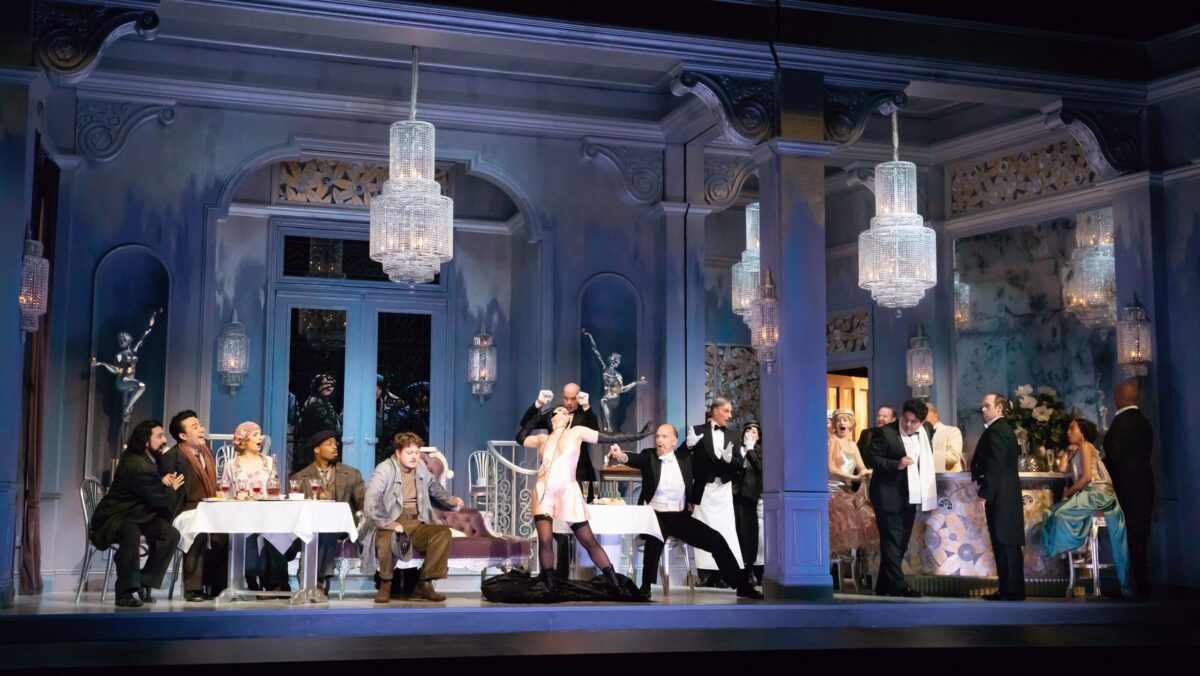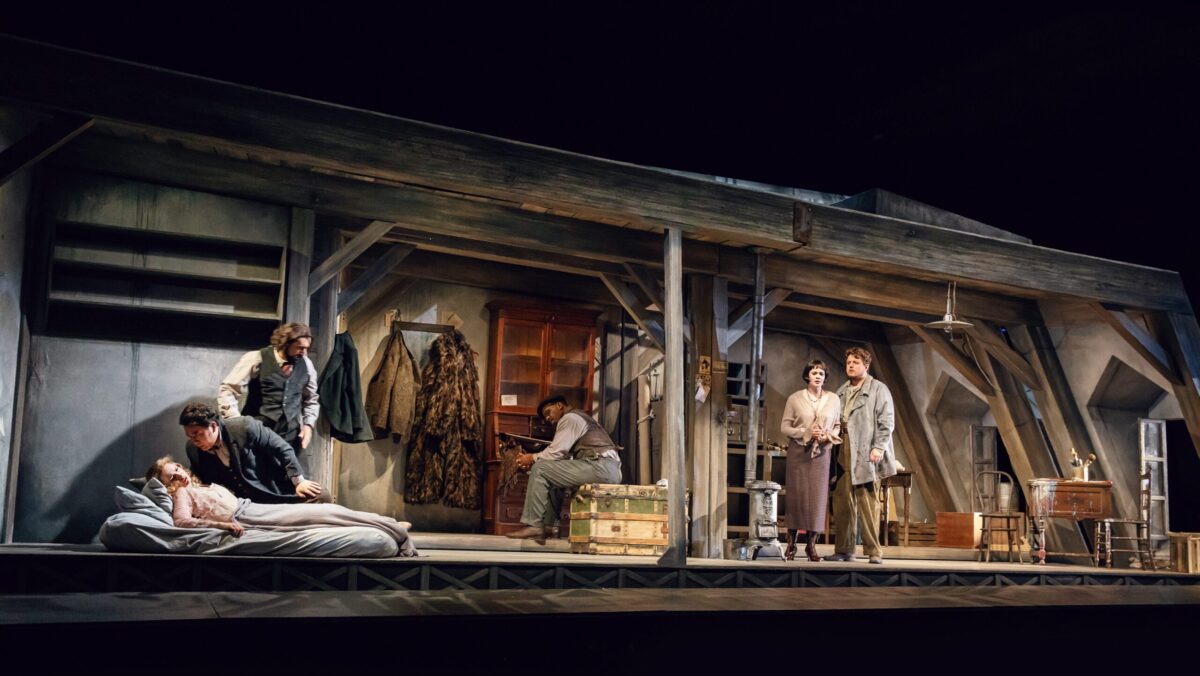

Curtis Brown for The Santa Fe Opera
In Act II of La bohème, Musetta comes on to nice acclaim from all people on stage, from the Bohemians to the youngsters hoping to purchase toys from Parpignol. She finally sheds her present paramour, Alcindoro by faking a sprained ankle from a broken shoe, in order that she will stroll off with outdated flame Marcello. Within the manufacturing by James Robinson at The Santa Fe Opera, earlier than that time, she flings off her outer garment –– an extended, feathered quantity that is likely to be a coat or is likely to be a gown –– leaving her in a camisole, culottes, and stockings.
Positive, this will get a number of consideration, along with affirming the axiom that at Santa Fe, at the very least one scantily-clad singer will wind up freezing on stage when the rains –– or at the very least the damp –– shut in on the open-sided Crosby Theatre. (On 28 July, the icicle singer was Emma Marhefka.) However it additionally distracts the viewers from the more-important incident with the shoe, which comes a bit later and which barely registered right here. This is only one manner that Robinson’s replace to the Twenties, and his frankly weak course, undermined the effectiveness of this nice opera.
I’ve loved, and realized loads from, many up to date productions (David Pountney’s Rusalka at Santa Fe in 2023 can be one instance), however I noticed no positive aspects from this staging, although it had some good factors. It was cute to see Rodolfo banging away on a typewriter, and the ladies’s Twenties outfits, by costume designer Constance Hoffman, actually regarded good. The Japanese prints on the wall behind Marcello in Act I had been a pleasant contact, and people weren’t well-known in Europe till pretty late within the nineteenth c. Scenic designer Allen Moyer gave the garret set low ceilings and a charmingly acceptable smoking stovepipe above the roof.
However a lot else appeared incorrect. Within the Café Momus scene, the Bohemians had been apparently seated indoors, with a procession of fashionably dressed {couples} checking in with the maître d’hôtel behind them. Perhaps the Twenties setting justified this, however it felt off.
The Bohemians regarded too nicely dressed (excepting Marcello, whose coat confirmed some put on), too nicely fed, and, worst of all, too heat, although Acts I by way of III happen through the winter and Act III is fully outside. Poor Mimì, dying of tuberculosis, hardly coughed and infrequently appeared weakened by her debilitating sickness. Not solely that, however the staging of Act IV drew the viewers’s consideration away from Mimì by placing her on a floor-level mattress at viewers left whereas everybody else was on their ft and shifting round, viewers proper.
The singers had been all completely nice, however they had been undermined each by the staging and by overly loud conducting from Iván López Reynoso. It’s an ideal rating and you’ll perceive conductors desirous to let the orchestra rip, however for heaven’s sake: this was my third Bohème since final fall, and the third during which the orchestra was too loud.


Curtis Brown for The Santa Fe Opera
Simply as dangerous, or worse, López Reynoso’s conducting typically didn’t name correct consideration to essential moments occurring on stage. Sylvia D’Eramo’s “D’onde lieta usci” was underway earlier than I knew it, for instance.
Emma Marhefka’s Musetta fared nicely, her vivid soprano chopping simply by way of the orchestra. Szymon Mechliński has a giant voice that may simply be overkill for Marcello – and he was directed to be a coarser, much less sympathetic character than you normally see, an fascinating (and supportable) alternative on Robinson’s half. He wasn’t a very sympathetic pal to Rodolfo and was extra offended than harm at Musetta’s habits. Nonetheless, it’s greater than a little bit exhausting to swallow Marcello disappearing with a streetwalker right into a Crimson Cross van on the finish of Act III.
There wasn’t lots of chemistry between Lengthy Lengthy’s Rodolfo and D’Eramo’s Mimì, alas, nor did both of them make a powerful particular person impression vocally or dramatically. D’Ermano’s soft-grained voice didn’t contribute a lot to her character’s fragility, although it may have. Soloman Howard was a sonorous Colline. The manufacturing put his towering dimension to good use when he briefly carried across the much-smaller Efraín Solís, who sang an enthralling Schaunard. The veteran Kevin Burdette was environment friendly as Benoît and Alcindoro.
Lisa Hirsch
Lisa Hirsch studied music at Brandeis College and Stony Brook. She studied flute severely for a variety of years and has sung all kinds of music in lots of choruses. She has written about opera and classical music for San Francisco Classical Voice, Opera Information (RIP), Opera, and the San Francisco Chronicle. She blogs about these topics at Iron Tongue of Midnight, which additionally consists of lots of her images.
Although she has attended San Francisco Opera and different corporations because the early Nineteen Eighties, her opera obsession actually began within the early 90s, when she began listening to historic singers.
